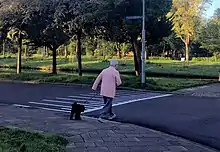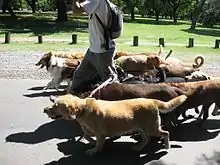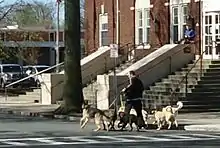Dog walking
Dog walking is the act of a person walking with a dog, typically from the dog's residence and then returning. Leashes are commonly used for this. Both owners and pets receive many benefits,[1] including exercise and companionship.[2]


Description

Dogs are restrained by a collar around their neck or by a harness,[3] or by simply following their guardian by familiarity and verbal control. Commonly, the dog is walked by the guardian, or by another family member, but there are also professional dog walkers.[4]
Health benefits
A study by Michigan State University showed that people who walk their dogs are 34% more likely to meet expected levels of exercise, with a recommended level of 150 minutes of activity such as dog walking per week. Matthew Reeves, the co-author of the study said, "There is no magic bullet in getting people to reach those benchmarks but walking a dog has a measurable impact."[5]
Research conducted by the University of Western Australia has suggested that a higher rate of dog walking within a community tends to cause more interpersonal relationships within that community. The research suggested that people in the community would acknowledge and greet other people in the street, and exchange favors with neighbors, which could possibly encourage more exercise in the community, by giving pets and owners a chance at a healthier lifestyle.
Professional dog walkers

Professional dog walkers, both individuals and businesses, are paid by dog owners to walk their dogs for them. Some dog walkers will take many dogs for a walk at once, while others will only take a single dog.[4] The length of a walk might vary by breed or owners request ranging from short relief walks to longer walks with a specific amount of time set by the owner. Also growing in popularity is "dog running". [6] Dog runners are professionals who run with dogs, rather than walking with them. In some jurisdictions, dog walking businesses must be licensed and have employees trained in animal first aid. Professional dog walking services can be obtained locally or through online referral services. Obtaining a position as a professional dog walker has become more difficult, with applicants having to pass rigorous exams and go through extensive training.[7] However, regardless if licensing or training is required, all dog walkers who walk other people's dogs must be aware of best practices such as using a fixed-length leash and weather considerations.
In the United States, the first professional dog walker is believed to have been Jim Buck, who in 1960 launched his dog walking service in New York City.[8]
See also
References

- "Are new rules woof justice for pooches?". Grimsby Telegraph. thisisgrimsby.co.uk. 29 May 2010. Archived from the original on 13 September 2012. Retrieved 30 May 2010.
- Bumgardner, Wendy (13 November 2008). "Dog Owners Get Twice as Much Exercise - Dog Walking for Exercise". About.com. Retrieved 30 May 2010.
- Shaw, Lorrie (5 May 2010). "Commercialism: coming to a pet near you". AnnArbor.com. Retrieved 30 May 2010.
- Smith, Mark (5 May 2010). "Lawyer wants to bring dog walkers to heel". The Scotsman. Retrieved 30 May 2010.
- "Walkies Not Just For Dogs". Daily Express. 12 March 2011.
- Full-time Dog Runner, runnersworld.com, retrieved 8 June 2018
- Higgins, Laine (2017-10-05). "Want a Job as a Dog Walker? It's Just Like Getting into Harvard". Wall Street Journal. ISSN 0099-9660. Retrieved 2018-01-20.
- Fox, Margalit (12 July 2013). "Jim Buck, Who Made Walking Dogs a Job, Dies at 81". The New York Times. Retrieved 13 July 2013.
External links
 Media related to Dog walking at Wikimedia Commons
Media related to Dog walking at Wikimedia Commons